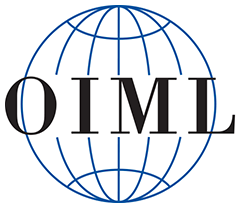Related Research Articles
Accuracy and precision are two measures of observational error.
In measurement technology and metrology, calibration is the comparison of measurement values delivered by a device under test with those of a calibration standard of known accuracy. Such a standard could be another measurement device of known accuracy, a device generating the quantity to be measured such as a voltage, a sound tone, or a physical artifact, such as a meter ruler.

Metrology is the scientific study of measurement. It establishes a common understanding of units, crucial in linking human activities. Modern metrology has its roots in the French Revolution's political motivation to standardise units in France when a length standard taken from a natural source was proposed. This led to the creation of the decimal-based metric system in 1795, establishing a set of standards for other types of measurements. Several other countries adopted the metric system between 1795 and 1875; to ensure conformity between the countries, the Bureau International des Poids et Mesures (BIPM) was established by the Metre Convention. This has evolved into the International System of Units (SI) as a result of a resolution at the 11th General Conference on Weights and Measures (CGPM) in 1960.

Hair analysis may refer to the chemical analysis of a hair sample, but can also refer to microscopic analysis or comparison. Chemical hair analysis may be considered for retrospective purposes when blood and urine are no longer expected to contain a particular contaminant, typically three months or less.

The International Organization of Legal Metrology, is an intergovernmental organisation that was created in 1955 to promote the global harmonisation of the legal metrology procedures that underpin and facilitate international trade.
Accreditation is the independent, third-party evaluation of a conformity assessment body against recognised standards, conveying formal demonstration of its impartiality and competence to carry out specific conformity assessment tasks.
ISO/IEC 17025General requirements for the competence of testing and calibration laboratories is the main standard used by testing and calibration laboratories. In most countries, ISO/IEC 17025 is the standard for which most labs must hold accreditation in order to be deemed technically competent. In many cases, suppliers and regulatory authorities will not accept test or calibration results from a lab that is not accredited. Originally known as ISO/IEC Guide 25, ISO/IEC 17025 was initially issued by ISO/IEC in 1999. There are many commonalities with the ISO 9000 standard, but ISO/IEC 17025 is more specific in requirements for competence and applies directly to those organizations that produce testing and calibration results and is based on more technical principles. Laboratories use ISO/IEC 17025 to implement a quality system aimed at improving their ability to consistently produce valid results. Material in the standard also forms the basis for accreditation from an accreditation body.
IEC 61508 is an international standard published by the International Electrotechnical Commission (IEC) consisting of methods on how to apply, design, deploy and maintain automatic protection systems called safety-related systems. It is titled Functional Safety of Electrical/Electronic/Programmable Electronic Safety-related Systems.
ISO 15189 Medical laboratories — Requirements for quality and competence is an international standard that specifies the quality management system requirements particular to medical laboratories. The standard was developed by the International Organisation for Standardization's Technical Committee 212. ISO/TC 212 assigned ISO 15189 to a working group to prepare the standard based on the details of ISO/IEC 17025:1999 General requirements for the competence of testing and calibration laboratories. This working group included provision of advice to medical laboratory users, including specifics on the collection of patient samples, the interpretation of test results, acceptable turnaround times, how testing is to be provided in a medical emergency, and the lab's role in the education and training of health care staff. While the standard is based on ISO/IEC 17025 and ISO 9001, it is a unique document that takes into consideration the specific requirements of the medical environment and the importance of the medical laboratory to patient care.
The International Laboratory Accreditation Cooperation or ILAC started as a conference in 1977 to develop international cooperation for facilitating trade by promoting the acceptance of accredited test and calibration results. In 1996, ILAC became a formal cooperation with a charter to establish a network of mutual recognition agreements among accreditation bodies that would fulfil this aim.

Certified reference materials (CRMs) are 'controls' or standards used to check the quality and metrological traceability of products, to validate analytical measurement methods, or for the calibration of instruments. A certified reference material is a particular form of measurement standard.
A test method is a method for a test in science or engineering, such as a physical test, chemical test, or statistical test. It is a definitive procedure that produces a test result. In order to ensure accurate and relevant test results, a test method should be "explicit, unambiguous, and experimentally feasible.", as well as effective and reproducible.
The South African National Accreditation System (SANAS) is the official accreditation body for South Africa. Founded in 1996, SANAS is headquartered in Pretoria, South Africa. SANAS accreditation certificates are a formal recognition by the Government of South Africa that an organisation is competent to perform specific tasks.

Cerilliant Corporation, located in Round Rock, Texas, is a manufacturer of certified reference standards and certified reference materials providing products and services to forensic / toxicology, diagnostic/clinical, environmental, natural products, and pharmaceutical industries. Cerilliant is accredited to ISO Guide 34 & ISO/IEC 17025 and certified to ISO 13485 and ISO 9001:2008.

National Accreditation Board for Testing and Calibration Laboratories (NABL) provides accreditation to Conformity Assessment Bodies (Laboratories) in India. NABL Schemes include Accreditation (Recognition) of Technical competence of testing, calibration, medical testing laboratories, Proficiency testing providers (PTP) & Reference Material Producers (RMP) for a specific scope following ISO/IEC 17025, ISO 15189, ISO/IEC 17043 & ISO 17034:2016 Standards. It has Mutual Recognition Arrangement (MRA) with Asia Pacific Accreditation Cooperation (APAC), International Laboratory Accreditation Cooperation (ILAC).

HCT Co., Ltd. is a South Korean compliance testing and equipment calibration company that also develops particle counters and antennas. Founded in 2000 as Hyundai Calibration & Certification Technologies Co., the company is a spin-off from Hyundai Electronics, the world's second-largest memory chipmaker. HCT has testing and calibration sites in Korea, the United States, and China.

Founded in 2009, "Runningland Metrology & Testing (Shanghai) Co., Ltd" is a Shanghai-based accredited third party laboratory that specializes in instruments metering, condition monitoring, calibration and testing petrochemical products. The company was founded by David Zhou, who is an active member of STLE ASTM D2 Committee, and SAE, and co-founded by Ti Zhou who is a member of Shanghai Lubrication Trade Association. As a commercial third party laboratory, the organization also collaborates with educational institutions and research associations across China. Oil analysis is still a relatively developing idea and has become an increasingly important concept in The People's Republic of China. Because the oil analysis market in China is growing, Runningland has developed a lab that specializes in grease testing. In 2015, STLE has published a report indicating its previous activities and plans to expand into the China market by organizing the China Advisory Council, which consists of 15 prominent members of China's lubrication industry including David Zhou, Chairman and Co-founder of Runningland.
The Joint Committee for Guides in Metrology (JCGM) is an organization in Sèvres that prepared the Guide to the Expression of Uncertainty in Measurement (GUM) and the International Vocabulary of Metrology (VIM). The JCGM assumed responsibility for these two documents from the ISO Technical Advisory Group 4 (TAG4).
The National Association of Testing Authorities (NATA) is the recognised national accreditation authority for analytical laboratories and testing service providers in Australia. It is an independent, not-for-profit organisation, governed by a board of directors that has representation from NATA members, industry, government and professional bodies.

VAMAS stands for Versailles Project on Advanced Materials and Standards. It is a collaborative project that was initiated at the 1982 G7 Economic Summit in Versailles to develop and promote standards for the characterisation of advanced materials, including surfaces, interfaces, thin films, and nanostructures. Using interlaboratory studies, the VAMAS project has developed a number of standard test methods and reference materials for a wide range of materials. These standards have been widely adopted by industry and academic researchers, and have contributed to the development of new materials and technologies.
References
- ↑ Spagnolo, Giuseppe, Schirripa; Papalillo, Donato; Cozzella, Lorenzo; Leccese, Fabio (September 15–17, 2014). "Forensic Metrology Uncertainty of Measurements in Forensic Analysis" (PDF). In Proc. Of 20th IMEKO TC-4 International Symposium Measurement of Electrical Quantities.
{{cite journal}}: CS1 maint: date format (link) CS1 maint: multiple names: authors list (link) - ↑ VOSK, TED. EMERY, ASHLEY F (2021). FORENSIC METROLOGY: scientific measurement and inference for lawyers, judges, and criminalists. S.l.: CRC PRESS. ISBN 978-0-367-77847-7. OCLC 1227271351.
{{cite book}}: CS1 maint: multiple names: authors list (link) - ↑ FERRERO, ALESSANDRO; SCOTTI, VERONICA (2022). Forensic Metrology. An Introduction to the Fundamentals of Metrology for Judges, Lawyers and Forensic Scientits. Springer Cham. pp. XII, 206. doi:10.1007/978-3-031-14619-0. ISBN 978-3-031-14618-3.
- 1 2 3 Vosk, Ted; Emery, Ashley F (2014). Forensic Metrology: Scientific Measurement and Inference for Lawyers, Judges, and Criminalists (1st ed.). Boca Raton: CRC Press. ISBN 9780429246210.
- ↑ Locard, Edmond (1912). "Laboratoire de police et Instruction criminelle". Bulletin de la Société d'anthropologie de Lyon. 31 (1): 127–164. doi:10.3406/linly.1912.12670. ISSN 1160-641X.
- 1 2 Aitken, Colin G.G.; Taroni, Franco (2004). "Statistics and the Evaluation of Evidence for Forensic Scientists" (PDF). John Wiley & Sons.
- 1 2 Williams, Anna; Cassella, John P.; Maskell, Peter D., eds. (2017-04-07). Forensic Science Education and Training. Wiley. doi:10.1002/9781118689196. ISBN 978-1-118-68923-3.
- ↑ Willis, Sheila (March 8, 2015). "ENFSI Guideline for Evaluative Reporting in Forensic Science" (PDF). European Network of Forensic Science Institutes. ENFSI Guideline Document 1.1.1.
- ↑ Fernandes, Fábio A. O.; Alves de Sousa, Ricardo J.; Ptak, Mariusz (2018), "Application of Numerical Methods for Accident Reconstruction and Forensic Analysis", Head Injury Simulation in Road Traffic Accidents, Cham: Springer International Publishing, pp. 59–98, doi:10.1007/978-3-319-89926-8_4, ISBN 978-3-319-89925-1 , retrieved 2024-04-17
- ↑ Wallace, Jack (2010-04-16). "Proficiency Testing as a Basis for Estimating Uncertainty of Measurement: Application to Forensic Alcohol and Toxicology Quantitations". Journal of Forensic Sciences. 55 (3): 767–773. doi:10.1111/j.1556-4029.2010.01344.x. ISSN 0022-1198. PMID 20345793.
- 1 2 Gambino, Carol; McLaughlin, Patrick; Kuo, Loretta; Kammerman, Frani; Shenkin, Peter; Diaczuk, Peter; Petraco, Nicholas; Hamby, James; Petraco, Nicholas D. K. (2011-06-27). "Forensic surface metrology: tool mark evidence". Scanning. 33 (5): 272–278. doi:10.1002/sca.20251. ISSN 0161-0457. PMID 21710632.
- ↑ Tzou, Chieh-Han John; Artner, Nicole M.; Pona, Igor; Hold, Alina; Placheta, Eva; Kropatsch, Walter G.; Frey, Manfred (2014). "Comparison of three-dimensional surface-imaging systems". Journal of Plastic, Reconstructive & Aesthetic Surgery: JPRAS. 67 (4): 489–497. doi:10.1016/j.bjps.2014.01.003. ISSN 1878-0539. PMID 24529695.
- 1 2 3 Krismastuti, Fransiska Sri Herwahyu; Habibie, Muhammad Haekal (2022-10-19). "Complying with the resource requirements of ISO/IEC 17025:2017 in Indonesian calibration and testing laboratories: current challenges and future directions". Accreditation and Quality Assurance. 27 (6): 359–367. doi:10.1007/s00769-022-01523-w. ISSN 0949-1775. PMC 9579603 . PMID 36275871.
- ↑ "Revised ILAC P10 published - ILAC". ILAC - ILAC Live Site. 2020-07-10. Retrieved 2024-04-17.
- ↑ Practice for Use of the Terms Precision and Bias in ASTM Test Methods, ASTM International, doi:10.1520/e0177-06 , retrieved 2024-04-17
- ↑ "forensic toxicology proficiency-testing: Topics by WorldWideScience.org". worldwidescience.org. Retrieved 2024-04-17.
- ↑ Vosk, Ted (2014). Forensic Metrology A Primer for Lawyers and Judges (2nd ed.). CRC/Taylor Francis.
- ↑ de Campos, Eduardo Geraldo; da Costa, Bruno Ruiz Brandão; dos Santos, Fabiana Spineti; Monedeiro, Fernanda; Alves, Marcela Nogueira Rabelo; Santos Junior, Wilson José Ramos; De Martinis, Bruno Spinosa (2021-08-19). "Alternative matrices in forensic toxicology: a critical review". Forensic Toxicology. 40 (1): 1–18. doi:10.1007/s11419-021-00596-5. ISSN 1860-8965. PMC 9715501 . PMID 36454488.
- ↑ "Digital Evidence and Forensics | National Institute of Justice". nij.ojp.gov. Retrieved 2024-04-17.
- ↑ Gruber, B.; Weggler, B.A.; Jaramillo, R.; Murrell, K.A.; Piotrowski, P.K.; Dorman, F.L. (2018). "Comprehensive two-dimensional gas chromatography in forensic science: A critical review of recent trends". TrAC Trends in Analytical Chemistry. 105: 292–301. doi:10.1016/j.trac.2018.05.017. ISSN 0165-9936.
- ↑ Piraianu, Alin-Ionut; Fulga, Ana; Musat, Carmina Liana; Ciobotaru, Oana-Roxana; Poalelungi, Diana Gina; Stamate, Elena; Ciobotaru, Octavian; Fulga, Iuliu (2023-09-19). "Enhancing the Evidence with Algorithms: How Artificial Intelligence Is Transforming Forensic Medicine". Diagnostics. 13 (18): 2992. doi: 10.3390/diagnostics13182992 . ISSN 2075-4418. PMC 10529115 . PMID 37761359.
- ↑ Aitken, Colin G.G.; Taroni, Franco (2004). "Statistics and the Evaluation of Evidence for Forensic Scientists" (PDF). John Wiley & Sons.
- ↑ Wilson-Wilde, Linzi (2018). "The international development of forensic science standards — A review". Forensic Science International. 288: 1–9. doi:10.1016/j.forsciint.2018.04.009. ISSN 0379-0738. PMID 29705583.
- ↑ "The Role and Impact of Forensic Evidence in the Criminal Justice System". Indian Journal of Forensic Medicine & Toxicology. 15 (1). 2021. doi:10.37506/ijfmt.v15i1.17794. ISSN 0973-9122.
- ↑ Saks, Michael J.; Koehler, Jonathan J. (2005-08-05). "The Coming Paradigm Shift in Forensic Identification Science". Science. 309 (5736): 892–895. Bibcode:2005Sci...309..892S. doi:10.1126/science.1111565. ISSN 0036-8075. PMID 16081727.
- ↑ Vosk, Ted (2014). Forensic Metrology A Primer for Lawyers and Judges (2nd ed.). CRC/Taylor Francis.
- ↑ Council, National Research (2009-07-01). "Strengthening Forensic Science in the United States: A Path Forward". CrimRxiv. doi:10.21428/cb6ab371.b2d683d2.
- ↑ Saks, Michael J.; Koehler, Jonathan J. (2005-08-05). "The Coming Paradigm Shift in Forensic Identification Science". Science. 309 (5736): 892–895. Bibcode:2005Sci...309..892S. doi:10.1126/science.1111565. ISSN 0036-8075. PMID 16081727.
- ↑ Yadav, Praveen Kumar (2017). "Ethical issues across different fields of forensic science". Egyptian Journal of Forensic Sciences. 7 (1): 10. doi: 10.1186/s41935-017-0010-1 . ISSN 2090-5939. PMC 5514178 . PMID 28775903.